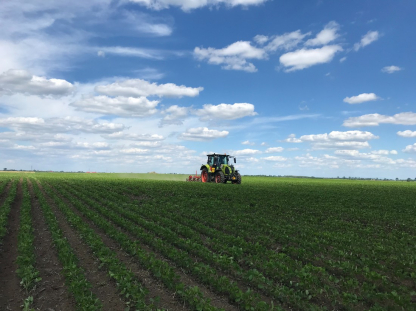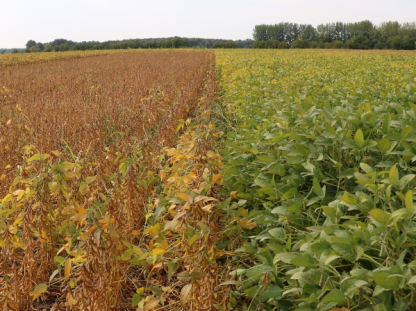Alternative technologies for soybean production
We have written about sowing soy as a second crop more than once already, as a new cultivation technology that still has a great deal of potential, both in terms of increasing the area under soy cultivation and of optimal land use.
Now we present the soybean production technology of an organic crop farm where soybean production started only two years ago, but where they are already working on “two fronts”, with a first crop and then a second crop.
First and second crop soy cultivation technology at Munkácsy-tej Ltd. in Gyulavár, Hungary
The farm and its legal predecessor, Körös-Maros Biofarm, began farming organically in 1999. It has 350 hectares of arable land and 150 hectares of pasture. Their most important crops are: maize, vetch, triticale, and autumn fodder mixture (peas, vetch, rye, oats, triticale). The typical soil type is meadow chernozem, with a humus content of 1.5-2.5%.
The farm is located in a dry area of the Southern Great Plain region of Hungary. They wish to produce as much feed as possible locally for their own cattle herd. It is for this reason that soy, of which they had no previous experience on the farm, came to the fore.
The 2020 season was difficult. May and June were extremely wet (almost 260mm of rain fell during these two months). This hampered effective weed control, especially for the first crop of soy. In terms of overall useful heat in this area, it is possible to grow soy varieties which ripen at different times. The second sowing is made possible because that area is used to grow a fodder mix which is harvested early. Of course, super-early varieties (000) are to be used in such circumstances.
Table 1: Soy cultivation procedures at Munkácsy-tej Ltd. in 2020
|
Operation |
First sowing |
Second sowing |
|
Basic tillage |
Soil loosening with a field cultivator (Bednar Terraland) in autumn |
10/06 Shallow tillage (compact disc harrow)
|
|
Seedbed preparation |
16/3, 21/04 seedbed cultivator -sprung tines can be attached to goosefoot tines for improved weeding performance |
12/06 seedbed cultivator |
|
Sowing |
23/04 45 cm row spacing 500 000 seeds per hectare Väderstad Tempo 8/6 planter (adjustable row spacing) |
13/06-15/06 45 cm row spacing 600 000 seeds per hectare Väderstad Tempo 8/6 planter |
|
Type |
Regale (I) |
Viola (000) |
|
Early weed control |
Blind cultivation - 4 days after sowing -10 days after emergence Weeding harrow (Regent 10 m) |
Blind cultivation (not done, due to 40 mm of rain) |
|
Inter-row cultivation |
15/05, 28/05 Inter-row cultivator 2 x |
06/07 Inter-row cultivator 2 x |
|
Harvest |
24/09-28/09 With Claas Lexion combine With 6-7 % moisture content |
24/09-28/09 With Claas Lexion combine With 8-9 % moisture content |
Overall experience of second sowing
- There is sufficient time for soil preparation and sowing after the compound feed been removed.
- The weed situation was more manageable than in the main sowing, even though blind harrowing was not done.
- A much larger number of plants could have been used due to the small habitus of the 000 early maturing variety.
- The super-early variety is able to mature within the growing period of the first-sown crops in this region.
- Harvesting is made more difficult by lower pods close to the soil surface, meaning that a flat soil surface and precise harvester are particularly crucial.
- Although in 2020 the average yield (1.2t/ha) was lower than for the first sowing (2.4t/ha), this area produced a harvest of fodder before the soy, so profitability must be assessed for the whole year.
In 2021, the farm will test several super-early varieties together with ÖMKi, examining the possibilities of increasing yields through variety selection.
Ágnes Tünde Ráki and Dr Éva Hunyadi Borbélyné
.jpg)
.jpg)
.jpg)
.jpg)


.jpg)





